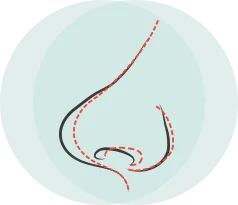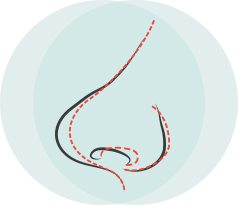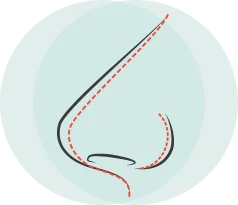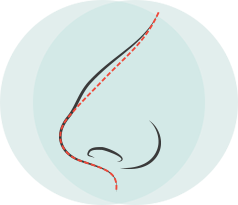If you’re considering nose reshaping surgery and want to learn more, Dr. Sepehr has provided answers to some of the most commonly asked questions about this procedure. For more information, or to schedule a consultation, please reach out to our team online or by phone.
What if I have a deviated septum?
A deviated septum can make breathing more difficult, and this concern may or may not be visible externally. This issue can usually be corrected during a rhinoplasty, as part of a plan to enhance both the aesthetics and the function of the nose. If you just want to address the deviated septum, a technique called septoplasty can be performed. It is designed to modify the placement of the bone and cartilage that separates the nostrils from one another. By changing the structure to enhance breathing, the appearance of the nose may also be affected. Dr. Sepehr takes great care in providing a cosmetically appealing result that best suits the proportion of your face and features.
How long does it take to recover after rhinoplasty?
Swelling, bruising, and tenderness are common for the first few weeks, and you should expect to take at least a week off from your job, classes, and other responsibilities. You should also avoid strenuous exertion for at least four to six weeks, as this can cause additional swelling and may affect the length of the recovery process or your result. Dr. Sepehr will provide more specific instructions for you based on your treatment plan. While some residual swelling may still be present, most patients have a good idea of the final outcome after two to three months.
Can rhinoplasty be combined with other procedures?
Absolutely. We will tailor your treatment to best suit your anatomic needs and expressed goals. If you would also like to rejuvenate other areas of your face, both surgical and non-surgical options are available. Many patients like to enhance other features while improving the look of the nose. We offer a comprehensive range of cosmetic options for the face, including dermal fillers, laser skin resurfacing, and surgical techniques. Rhinoplasty should be performed by a qualified surgeon. If you would like more information on the rhinoplasty procedure, or you believe you are a good candidate for the cosmetic surgery, please contact Dr. Sepehr to schedule a consultation for rhinoplasty at our practice. He will be happy to address any concerns you may have about the surgery as well as answer any questions regarding other facial procedures during a one-on-one session.
How can I reduce swelling after rhinoplasty?
Swelling after rhinoplasty is completely normal and can last for months after surgery. While inflammation should subside as your recovery progresses, you can help decrease swelling by keeping the head elevated while sleeping (ensuring the nose is above the level of the heart), and avoiding alcohol and tobacco consumption.
When can I blow my nose after rhinoplasty?
Due to the fragility of the nasal bones and soft tissues after rhinoplasty, it’s necessary to avoid blowing your nose for at least one to two weeks after surgery. The exact amount of time you should exercise caution will depend on the technique used during surgery and whether a deviated septum was addressed. Not only can blowing the nose with excess force cause bleeding, but it may also affect the way the nose heals and alter the final outcome. To address any congestion in the nasal passages, you can carefully clean your nose with saline nasal spray.
How long should I wait after rhinoplasty before wearing glasses?
While the nose is healing, it’s very important to avoid putting unnecessary pressure on the nasal bridge. If you wear glasses, Dr. Sepehr recommends switching to contacts for approximately four to eight weeks after surgery. Wearing sunglasses should also be avoided until the nose is fully healed, or until Dr. Sepehr gives you clearance to do so.
Are there any recovery tips after rhinoplasty?
In the days and weeks following your rhinoplasty procedure, a fair amount of swelling can be expected and may last for the next few months. Until the healing process is complete, these recovery tips may help you experience a smoother period of downtime:
- If discomfort from the nose starts to radiate to the mouth and jaw, sticking to a soft-food diet can alleviate any soreness brought on by chewing.
- Sleep often encourages healing, so resting for the first 24 hours after surgery (with light ambulation) is usually recommended.
- Excessive salt intake can increase fluid retention and prolong swelling, therefore healthy meals consisting of fruits, veggies, protein, leafy greens, and antioxidant-rich foods can facilitate a more comfortable recovery period.
- Try to avoid hot showers, hot foods, and humid environments. Heat can aggravate swelling of the facial tissues, so staying cool and eating cold or room-temperature foods are generally the best approaches while your nose is in the initial stages of healing.
Should I get a rhinoplasty or facial implants?
Both the nose and chin can heavily influence the balance and profile of the rest of the face, leading many patients to consider adding chin augmentation to their rhinoplasty, or simply opting for a
chin implant alone. In general, a weak or recessed chin can make the nose seem larger; the lack of a defined chin profile can also make the face look asymmetrical. Depending on the shape and size of your nose, a custom-designed chin implant may be enough to achieve balance in your facial features. Dr. Sepehr will discuss all of your options with you and recommend the most ideal treatment plan based on your concerns and aesthetic goals.
What’s the difference between cosmetic and functional rhinoplasty?
Cosmetic and functional rhinoplasty are closely related, but they are not synonymous procedures and do not employ the same surgical techniques. The term “rhinoplasty” can refer to a wide range of improvements and enhancements. While nose surgery is frequently performed for cosmetic reasons, the procedure can also be utilized to correct functional imbalances in the nose. Form and function are closely intertwined when regarding the nasal structure, and a noticeable asymmetry on the outside may also indicate an internal misalignment. Likewise, modifying internal strips of tissue and cartilage to improve breathing can typically enhance the aesthetic symmetry of the nose as well. Therefore, cosmetic and functional rhinoplasty differ in purpose and technique, but often provide benefits for both the form and function of the nose. Whether you seek out rhinoplasty to enhance airflow or to achieve aesthetic proportion, both types of goals can be completed in the same procedure if desired.










